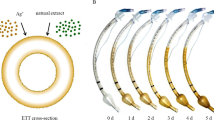Abstract
Ventilator associated pneumonia (VAP) is a serious and costly clinical problem. Specifically, receiving mechanical ventilation over 24 hours increases the risk of VAP and is associated with high morbidity, mortality and medical costs. This complication is especially hard to diagnose in children because of non-specific clinical signs and lack of established diagnostic methods. Cost effective endotracheal tubes (ETTs) that are resistant to bacterial infection would be essential tools for the prevention of VAP. In addition to their bacterial resistance, ETT with magnetic nanoparticles could aid in the diagnosis of VAP allowing physicians to locate infections with greater accuracy. The objective of this study was twofold, first to develop strategies to decrease bacterial adhesion on nano-rough ETT and secondly to develop better methods to assess in vitro bacterial adhesion or biofilm formation on ETT. In preliminary tests, nanomodified polyvinyl chloride (PVC) ETTs has been shown to be effective at reducing bacterial colonization. This study also sought to evaluate the bacterial resistance of these ETTs more effectively by creating a bench top airway model, which can create a similar environment to the flow system that ETTs are exposed to in vivo. The airway model designed to test ETTs has two Plexiglas chambers representing the oropharynx and the lungs, a tube representing the trachea and finally an intricate pumping system to the oropharynx with bacteria flow and to the lung with simulated compliance and resistance. ETTs were connected to a ventilator and passing the oropharynx into the trachea and observed under the mechanical ventilation and continuous bacterial flow system. In addition, the study examined dual gas flow conditions and their effect on bacterial growth of ETT. In no less than three separate trials in the airway chamber, each ETT will be tested for its effectiveness at the reduction of bacterial growth within the airway by sampling from both lung and oropharynx chambers during continuous operation. Special attention will be given to the long-term effects on the ETT by including a study that lasts longer than ten days. Both the bacterial proliferation in the two chambers and on the ETT itself will be carefully analyzed. This specialized testing should yield valuable information on the efficacy of nanomodified ETT in airway conditions and will provide further evidence to determine if nanomodified ETTs are a valid solution to VAP.
Similar content being viewed by others
References
Office of Quality and Performance, FY 2008, Q1 technical manual for the VHA performance measurement system, Oct, pp. 315 (2007).
F. K. Bahrani-Mougeot, B. J. Paster and S. Coleman “Molecular analysis of oral and respiratory bacterial species associated with ventilator-associated pneumonia,” J Clin Microbiology 45, 1588–1593 (2007).
H. Liu and T. J. Webster, “Nanomedicine for implants: a review of studies and necessary experimental tools.” Biomaterials, 28, 354–369 (2007).
S. Carson Fibronectin in Health and Disease New York: CRC Press, Inc. (2007).
J. J. Marini and A. S. Slutsky, Physiological basis of ventilatory support. New York: Marcel Dekker (1998).
P. Cardinal P. Jessamine C. Carter-Snell, S. Morrison and G. Jones . (1993), “Contribution of Water Condensation in Endotracheal Tubes to Contamination of the Lungs.” Chest, 127–129 (1993).
M. Hartmann J. Guttmann B. Muller T. Hallmann and K. Geiger “Reduction of the bacterial load by the silver-coated endotracheal tube (SCET) a laboratory investigation.” Technology and Health Care, 359–70 (1999).
National Center for Health Statistics, Center for Disease Control and Prevention, Clinical Growth Charts, August, Set 1 (2009)
D. Cheng and T. J. Webster, “Formation of nano surfaces on endotracheal tubes using bacterial lipase solutions.” Bioengineering Conference, IEEE 35th Annual Northeast, 1-2 (2008).
W. C. Wilson, C. M. Grande, and D. B. Hoyt, Trauma Emergency Resuscitation, Perioperative Anesthesia, Surgical Management, Volume I. New York: Informa Healthcare (2007).
K.-J.M. Soderholm R. Mukherjee and J. Longmate “Filler Leachability of Composites Stored in Distilled Water or Artificial Saliva.” Journal of Dental Research, 1692-1699 (1996).
G. Balasundaram and T. J. Webster, “Nanotechnology and biomaterials for orthopedic medical applications.” Nanomedicine, 1(2): 169–176 (2006)
Author information
Authors and Affiliations
Rights and permissions
About this article
Cite this article
Mary, C.M., Chang, D., Thomas, J.W. et al. Assessment of Nanomodified Endotracheal Tubes in a Bench Top Airway Model. MRS Online Proceedings Library 1209, 806 (2009). https://doi.org/10.1557/PROC-1209-YY08-06
Received:
Accepted:
Published:
DOI: https://doi.org/10.1557/PROC-1209-YY08-06




